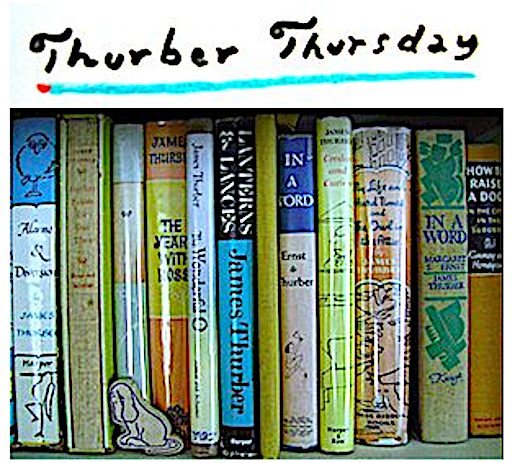It was a week ago today I set off to Columbus, Ohio with my New Yorker cartoonist colleague and wife, Liza Donnelly. We headed west to be on hand for the presentation (to Roz Chast) of very first Thurber Prize For American Humor in Cartoon Art. Our previous visits to Columbus had all been via plane — this time, we decided it would be fun to cover the twelve hundred miles (roughly six hundred each way) on the ground to see what was what between the Hudson River and the Olentangy River.
What I remember most from the drive was a lot of green space: enormous green fields, with the occasional smattering of small mostly contemporary buildings, and here and there an old house, and old barns. I thought about Thurber a lot on the trip. About his comings and goings between Columbus and New York. I imagine it was mostly by train back then. Had there been a fairly direct route between New York and Columbus I believe Liza and I would’ve hopped aboard instead of hopping into our car.
Just outside of Columbus, I started looking for the Columbus skyline. Hey, what can I tell you: I like skylines. When I was a kid growing up in New Jersey I loved that I could see the Manhattan skyline from my hometown — it seemed so close, but was, in some ways, so very far from the bedroom community vibe of Bloomfield. When we finally did behold the Columbus skyline (the above was pinched from the Columbus Chamber of Commerce — we neglected to take a photo as we zoomed into town) I was immediately taken by the oldest building I saw: the LeVeque Tower. In our previous trips to the city, it had never stood out before (possibly because my eyes were shut tight as we descended). The building resembles an ornate slender wedding cake.
Reading up on it a week later, I learned it was Columbus’s tallest building from its opening in 1927 until 1974, when it dropped to second tallest. Thurber surely noted it each time he ventured home (by 1927 he was living in New York — it was, in fact, the year he sold his first piece to The New Yorker, “An American Romance.” 
The focus of the trip to Columbus was, of course, the Thurber Prize Awards ceremony. This year was extra special because of it being the inaugural prize for cartoon art. We cartoonists who live by the single panel (and sometimes multiple panels, which somehow magically — as in Ms. Chast’s case — add up, quilt-like, to one panel) don’t have a lot of opportunities for our art to be ceremoniously feted. No matter what one thinks about the pros and cons of awards, applause, and prizes, it feels good to celebrate sometimes. Celebrating Thurber’s significant contribution to cartoon art, and an individual’s significant contribution, felt good.
 Every trip I make to Columbus (I believe it was visit #4 for me — Liza’s 5th) requires a visit to Thurber House (it’s at 77 Jefferson Avenue).This was the most crowded it’s been on one of our visits. Thurber’s granddaughter, Sara Thurber Sauers and her husband were there, as well as the Thurber Prize finalists for written humor, and the soon-to-be-announced Thurber Prize for Cartoon Art winner, Ms. Chast. Full house! I took time to slowly re-explore various rooms, listening to docent, Steve Andersson, regale the visitors with My Life And Hard Times tales along with Thurber family history.
Every trip I make to Columbus (I believe it was visit #4 for me — Liza’s 5th) requires a visit to Thurber House (it’s at 77 Jefferson Avenue).This was the most crowded it’s been on one of our visits. Thurber’s granddaughter, Sara Thurber Sauers and her husband were there, as well as the Thurber Prize finalists for written humor, and the soon-to-be-announced Thurber Prize for Cartoon Art winner, Ms. Chast. Full house! I took time to slowly re-explore various rooms, listening to docent, Steve Andersson, regale the visitors with My Life And Hard Times tales along with Thurber family history.
 However amplified Thurber’s stories were of life at 77 Jefferson, they’ve stuck with me forever as fact. I look up at light fixtures in the house and imagine electricity leaking, and imagine Thurber waking his sleeping father and demanding, “Name some towns in New Jersey!”
However amplified Thurber’s stories were of life at 77 Jefferson, they’ve stuck with me forever as fact. I look up at light fixtures in the house and imagine electricity leaking, and imagine Thurber waking his sleeping father and demanding, “Name some towns in New Jersey!”
I could go on and on about the various rewards of visiting, but let me say it in a nutshell: the drive will always be worth it.



